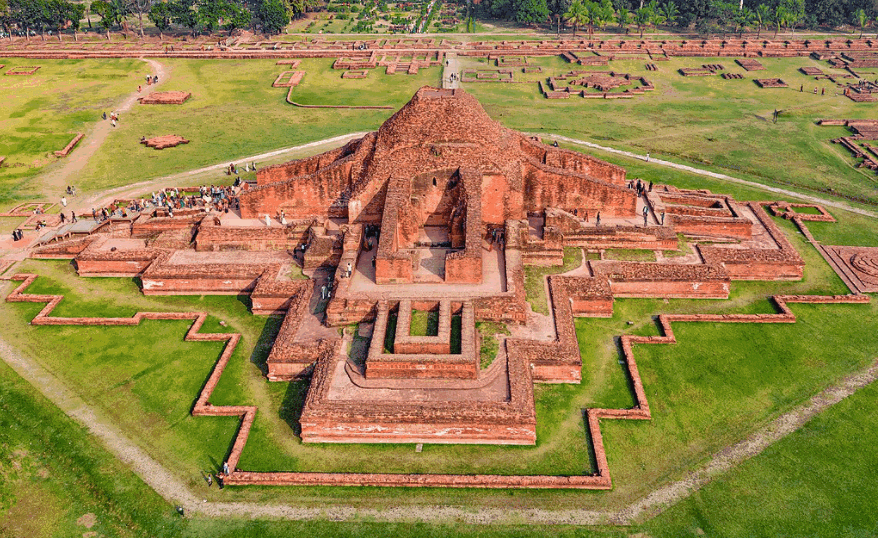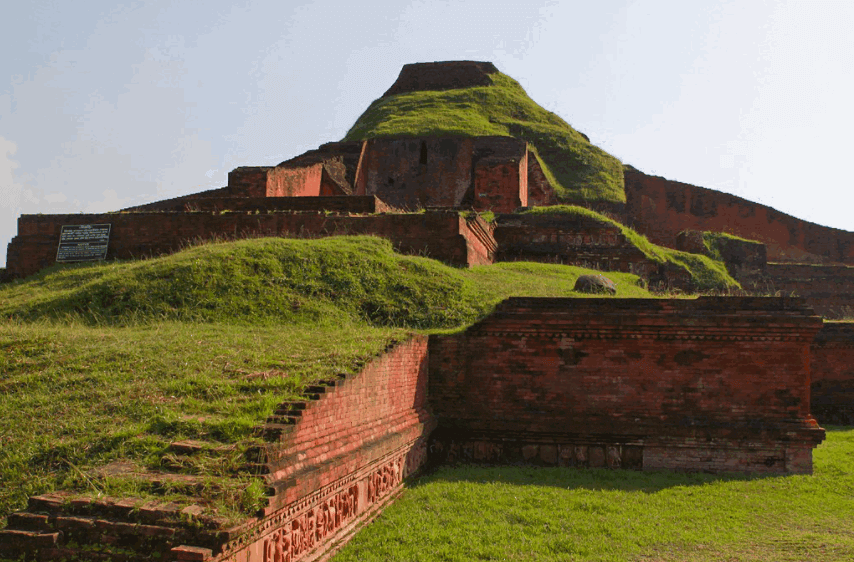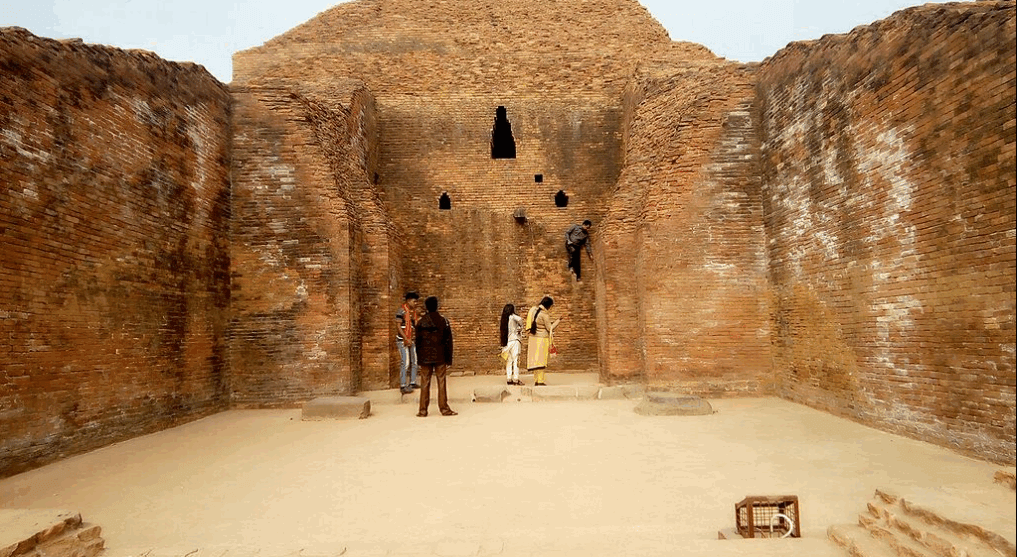
Paharpur Buddhist Vihara or Sompur Mahavihara is a ruined ancient Buddhist monastery located about 10 km north of Badalgachhi Upazila Sadar in the Naogaon district. Sri Dharmapaladeva, the second king of the Pala dynasty, was building this monastery in the late eighth or ninth century. PaharPur Buddhist Bihar is a historical place in Bangladesh History.
Sir Cunningham discovered this great feat in 1879. In 1985, UNESCO declared it a World Heritage Site. Paharpur can be called the largest Buddhist monastery in the world. In size, it can be compared to Nalanda Mahavihara in India.
It has been a very famous Buddhist center for 300 years. Not only from different parts of the subcontinent but also from China, Tibet, Myanmar (then Burma), Malaysia, Indonesia, etc., Buddhists used to come here to practice religion and acquire theology.
Table of Contents
What is Paharpur Buddhist Monastery Paharpur Buddhist
Monastery has an area of 922 feet in the north-south and 919 feet in the east-west. According to experts, Paharpur is one of the best places in the world to find antiquities in geometric designs so far. According to some, there was a Jain temple here. And this monastery has been built on top of that temple.
There are a total of 177 houses in this monastery. The houses were inhabited by Buddhist monks. There is a temple right in the middle of Bihar. The temple is 400 feet long, about 350 feet wide, and 70 feet high. In the evolution of time, the upper part of the temple has collapsed. On the outer wall, there are statues of Buddha, Hindu goddesses, and lots of burnt clay plaques. These paintings depict the varied life stories of the common people.
The walls of the main enclosure of Bihar are about 20 feet wide. There is another temple in the middle of the enclosure.

The land plan of the Buddhist monastery is quadrangular. The north and south sides are 263.6 m each and the east and west sides are 274.15 m. It was surrounded by wide boundary walls. There were small rooms lined up on the inside along the boundary walls. There are 45 rooms on the north side and 44 rooms on the other three sides.
Three floors of these rooms have been discovered. The bricks laid on each floor were made very thick with thick surki. In the last era, altars of different sizes were built on the floor in 92 rooms. This suggests that in the early period all the rooms were used as monks’ quarters, but later some rooms were converted into prayer rooms.

Each of the rooms has doors. These doors are wide on the inside but narrow on the outside. Niches are found in some rooms. There are a number of everyday items available on the floor of the rooms with niches. The inner chambers are 4.28 m long and 4.11 m wide. The back wall of the room i.e. the boundary wall is 4.8 m wide and the front wall is 2.44 m wide. The rooms have a 2.5 m wide verandah in front.
Each arm is connected by a staircase to the inner open courtyard. The main gate is along the middle of the northern arm of Bihar. It has a hall with one pillar on the outside and one on the inside and small chambers on the side. These cells were used for various purposes. There was another small entrance between the main gate and the northeast corner of Bihar.
The stairs that used to enter the open courtyard from here still exist today. There were similar staircases on the north, south, and west sides. Among them, there are only traces of west side stairs. There was a pond in front of the entrance on the north side until 1984.
According to the excavation data of 1984-85, the pond was excavated during the later period of the first construction period and the staircase in this part was destroyed. Later the pond was filled. During the excavation, silver coins of the reign of Caliph Harun al-Rashid were found in 125 earthenware vessels, which are preserved in the museum adjacent to Paharpur. Besides, many idols, coins, inscriptions, etc. recovered from Paharpur Bihar are preserved in Paharpur Museum.
The Ruins of The Central Temple Paharpur Bihar
In the middle of the open courtyard in the middle of Bihar are the ruins of the central temple. The wonderful original temple is a unique example of architecture. Extraordinary’s artistic plan. Around 2,000 magnificent terracotta plaques are found on the walls of the temple.
It is a daily reflection of the general public life of ancient Bengal. For example people, hunters, dancing women, shepherds, plants, flowers, animals, birds, elephants, horses, and many more. When you look around, you can see Sushma’s combination of aesthetic art. The main temple was in the middle of Bihar. At the center of the original plan is an empty quadrangular chamber without doors and windows. This chamber extends from the bottom of the temple to the top. Basically, the structure of this huge temple is built around this empty cell.
It has risen step by step like a pyramid. Here was the bypass. The temple is 400 feet long and 350 feet wide. The main temple was built by mixing mud with bricks. Historians believe that the eye-catching architectural style of the temple later influenced the construction of various monasteries in Burma, Cambodia, Java, Indonesia, and Bali. A brick-paved floor has been discovered in the central vacuum chamber.
This floor is located on the same level as the surrounding rooms and mandapa outside the room. But there is no way or door to the central room from the surrounding rooms and there is no evidence that it was there before, it was closed later. There is no altar or niche for keeping idols in the room. So it is assumed that this hollow bar was a material for the strong construction of the high walls of the temple. The statues were probably placed in the rooms around it.
Open Courtyard:
The ruins of some more buildings are found in the open courtyard in the middle of the monastery. The dining hall and kitchen are located in the south-eastern part of the courtyard. Between these two installations is a 48 m long brick paved drain and has three wells in a row.
There are also some dedicated stupas, administrative buildings, portraits of the central temple, etc. The stupa, located in the southeast among the dedication stupas, is 16-star-shaped. Adjacent to a low platform is a pucca well adjacent to the mound. Apart from this, there are scattered administrative buildings, kitchens, dining halls, dedication stupas, wells, etc.
It is basically an installation located outside Bihar. A number of baths and toilets were built on a platform 28 m south of the south wall of Bihar. It is connected by a paved path from Room 102 in Bihar. Below this path is a vaulted arch parallel to the walls of the monastery. This was probably done to facilitate free movement of water outside the monastery and drainage around it.
Sandhyavati Ghat:
There is a paved ghat outside the wall from the southeast corner of Bihar. It is called Sandhyavati Ghat. Sandhyavati, the daughter of Raja Maidalan, used to bathe regularly in this ghat. A river flowed by the side of Bihar. Each wall on either side is 1.5 m wide. The ghat is sloping about 12 m below the surface.
Gandheshwari Temple
There is a temple outside the east-facing wall 12 m west of the bathing ground. On the south wall of the temple, there is a statue of the Buddhist goddess Padmapani. It is locally called Gandheshwari temple. It is 6.7 m long and 3.5 m wide. The bricks on the front wall look like a full-blown lotus with various flower designs and elements used in the masonry. It has a rectangular hall.
The lower part of an octagonal pillar is found in the middle of the hall. On the outside of a wall rising to the west is a square worship room with a 1.4 m arm. Besides, there are arrangements for placing idols in the four niches of the hall. There is a courtyard in front of the temple. Its floor is built of vertically laid bricks and the masonry is different from other architectural monuments of Paharpur.
Satyapir’s Vita:
Satyapir’s Vita is located 365 meters east of Paharpur Bihar. In this vita there are ruins of a star temple and lots of dedicated piles of different shapes and sizes. The identity of this Vita and Tara temple has been proved by the round terracotta seals engraved with about 50 terracotta plaques, eight-armed deities, and Buddhist scriptures at various places in the temple premises.
There are 132 offering stupas in the temple area. The offerings of various shapes and designs around the Temple testify to the abundance of sutapas and the fame and importance of its decoration. Among the stupas here, the quadrangular stupa located in the south-eastern part of the courtyard near the main temple is particularly noteworthy. The length of the sutapa is 3 m and the outer sutapa is decorated with ornate bricks.
Excavations have uncovered a paved memorial chamber of 1 m square in the center of the Sutap. The chamber was filled with portraits of several thousand small earthen offerings. It seems that thousands of pilgrims who came to the temple used to offer these in the memorial chambers as a symbol of their devotion and reverence.
How To Get To Paharpur Buddhist Monastery
You can come to Naogaon from any part of the country and reach the historic Paharpur by direct bus from the Naogaon Baludanga bus terminal. The approximate distance is approximately 32 km and the bus fare is 30-40 Tk. Or you can come to Joypurhat city from any part of the country and take a bus or autorickshaw to Paharpur Buddhist Monastery. The distance from Joypurhat to Paharpur Buddhist Monastery is only 13 kilometers. If you want to get off at Jamalganj station in Joypurhat by train, you have to take a van or autorickshaw if you want to come to Paharpur Buddhist monastery from here. The distance from Jamalganj to Paharpur Buddhist Monastery is only 5 kilometers.
Where to Stay In Visiting Time (Paharpur)
There is no arrangement for the public to stay in Paharpur. You have to come back day by day or you can stay at Upazila Sadar / District Sadar. However, there is a rest house nearby for VIPs to stay. Some of the hotels to stay in Naogaon are – Hotel Faryal, Hotel Avkash, Hotel Raj, Hotel Jamuna, Hotel Flood, Hotel Arrival at Mukti Mor, Hotel Sarani, and Motel Chisti.
You Can Also Check Them:
Places People About Search For:
- importance of paharpur
- paharpur bihar museum
- information of paharpur
- paharpur buddha bihar picture
- paharpur buddhist monastery
- where is paharpur
- history of paharpur buddha bihar bangla
- who discovered paharpur
